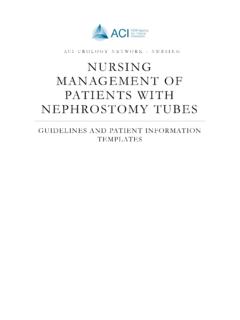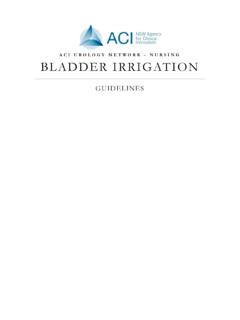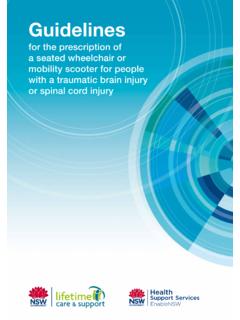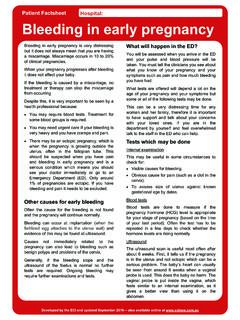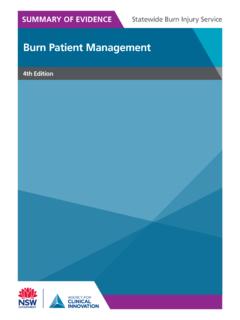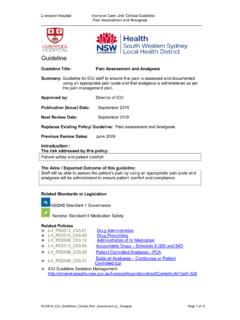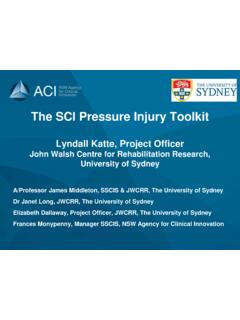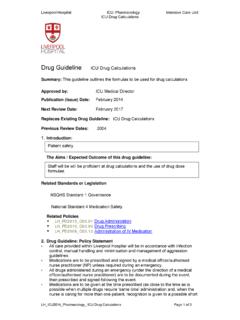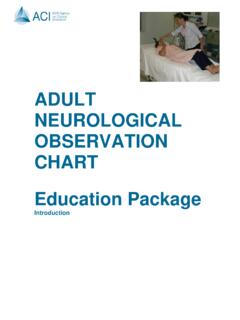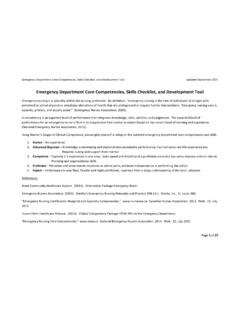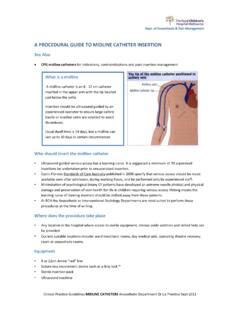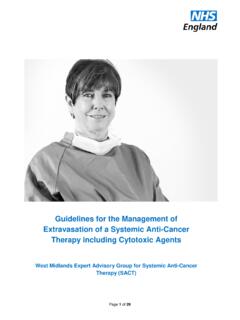Transcription of Central Venous Access Device Post Insertion Management
1 Central Venous Access Device post Insertion Management Guideline provenance Full title Central Venous Access Device post Insertion Management ( cvad -CPG) SHPN (ACI) 140007. Guideline owner Agency for Clinical Innovation ISBN 978-1-74187-953-7. Executive authorisation Dr Nigel Lyons CE ACI. Primary author Marghie Murgo Guideline development Vascular Access Specialists Intensive Care Specialists network members Tim Spencer CNC Jeff Breeding CNC. Evan Alexandrou CNS Bernie Baliotis CNE. Therese Hallett NUM Michelle Copede Guihermino Irena Martinich CNC Maree Frogley CNE. Julianne Denham Rachel Whyte Billian Ray-Barruel Prof Claire Rickard ICCMU Director Dr Sean Kelly Project Manager Kaye Rolls, RN ACC BAppSc(Syd) ICCMU & ACI. Project Officer Janet Masters, RN Crit Care Cert BHSc(Nur) MN ICCMU & NaMO. Version number Year published/implementation 2014.
2 Year for review 2017. Funding ACI-ICCMU is the primary project funder NaMO provided funding the Project Officer's salary Baxter Healthcare provided an unconditional education grant which was used to fund the 2012 project startup meeting. Baxter took no part in the process of developing any of the guidelines. Related NSW Health policies Infection Control Policy (PD2007_036). and guidelines Hand Hygiene Policy (PD2010_058). Infection Control Policy: Prevention & Management of Multi-Resistant Organisms (PD2007_084). NSW Work Health & Safety Act (2011). Disclaimer This clinical practice guideline (CPG) is aimed at providing clinicians working in NSW hospitals' intensive care units (ICU) with recommendations to frame the development of policies and procedures related to the cvad Management practices in adult ICUs. This CPG is a revision of 2007 cvad Management guideline and includes: 1) an update of the evidence base; 2) an evaluation of how this literature applies to the NSW intensive care context; 3) the extensive clinical knowledge of the guideline development network members (GDN); and 4) a consensus development process.
3 The CPG is not intended to replace the critical evaluation processes that underpin the development of local policy and procedure nor does it replace a clinician's judgment in an individual case. Users of this CPG must critically evaluate this CPG as it relates to local circumstances and any changes in the literature that may have occurred since the dates of the literature review conducted. In addition, NSW Health clinicians must review NSW State Government policy documents to identify any directives that may relate to this clinical practice. These guidelines are intended for use in NSW acute care facilities. Content within this publication was accurate at the time of publication. This work is copyright. It may be reproduced in whole or part for study or training purposes subject to the inclusion of an acknowledgment of the source. It may not be reproduced for commercial usage or sale.
4 Reproduction for purposes other than those indicated above, requires written permission from the Agency for Clinical Innovation. Suggested citation: Murgo M, Spencer T, Breeding J, Alexandrou E, Baliotis B, Hallett T, Guihermino M, Martinich I, Frogley M, Denham J, Whyte R, Ray-Barruel B. and Richard C (2014) Central Venous Access Device post Insertion Management . Agency for Clinical Innovation NSW Health Australia 978-1-74187-953-7. AGENCY FOR CLINICAL INNOVATION Agency for Clinical Innovation Level 4, Sage Building PO Box 699 Chatswood NSW 2057. 67 Albert Avenue, Chatswood NSW 2067 T +61 2 9464 4666 | F +61 2 9464 4728. E | Further copies of this publication can be obtained from the Agency for Clinical Innovation website at: Disclaimer: Content within this publication was accurate at the time of publication. This work is copyright. It may be reproduced in whole or part for study or training purposes subject to the inclusion of an acknowledgment of the source.
5 It may not be reproduced for commercial usage or sale. Reproduction for purposes other than those indicated above, requires written permission from the Agency for Clinical Innovation. Agency for Clinical Innovation 2014. i Central Venous Access Device post Insertion Management 2014. FOREWORD. Insertion of a Central Venous Access Device ( cvad ) is a common hospital procedure with an estimated 15,000 devices inserted in NSW Intensive Care Units every year. Despite being a common procedure it is not one without significant risks which include risks in the Insertion of the devices and those associated with having a cvad in situ either short or long term. These risks can include infection, malposition, pneumothorax, thrombosis, vascular injury and air embolus. The purpose of this guideline is to provide intensive care clinicians with best practice recommendations so that the evidence-based treatment and care can be delivered and patients can receive the therapy they need.
6 Developed under the auspices of the Intensive Care Best Practice Manual Project, this guideline highlights the ability of the Agency for Clinical Innovation (ACI) to facilitate strong working relationships with clinicians as well other executive branches of the Ministry. On behalf of the ACI, I would like to thank Susan Pearce, Chief Nursing and Midwifery Officer for providing state executive sponsorship for the project and funds for the Project Officer. I would also like to extend my appreciation to the LHD executives for facilitating the participation of LHD staff in developing these guidelines, which I commend to you the clinicians of NSW. Dr Nigel Lyons Chief Executive, Agency for Clinical Innovation ABOUT THE ACI. The Agency for Clinical Innovation (ACI) works with clinicians, consumers and managers to design and promote better healthcare for NSW.
7 It does this by: Service redesign and evaluation applying redesign methodology to assist healthcare providers and consumers to review and improve the quality, effectiveness and efficiency of services. Specialist advice on healthcare innovation advising on the development, evaluation and adoption of healthcare innovations from optimal use through to disinvestment. Initiatives including Guidelines and Models of Care developing a range of evidence-based healthcare improvement initiatives to benefit the NSW health system. Implementation support working with ACI Networks, consumers and healthcare providers to assist delivery of healthcare innovations into practice across metropolitan and rural NSW. Knowledge sharing partnering with healthcare providers to support collaboration, learning capability and knowledge sharing on healthcare innovation and improvement.
8 Continuous capability building working with healthcare providers to build capability in redesign, project Management and change Management through the Centre for Healthcare Redesign. ACI Clinical Networks, Taskforces and Institutes provide a unique forum for people to collaborate across clinical specialties and regional and service boundaries to develop successful healthcare innovations. A priority for the ACI is identifying unwarranted variation in clinical practice and working in partnership with healthcare providers to develop mechanisms to improve clinical practice and patient care. ii Central Venous Access Device post Insertion Management 2014. Table 1: Guideline development network members GUIDELINE Management TEAM. Professor Claire Rickard Academic Mentor Griffith University Marghie Murgo, Chair Royal Prince Alfred Hospital Clinical Nurse Consultant Intensive Care Service Tim Spencer, Clinical Nurse Consultant Central Co-chair Practice Liverpool Hospital Venous Access & Parenteral Nutrition Service Jeff Breeding, Co-chair Evidence St Vincent's Health Network Clinical Nurse Consultant Intensive Care Services Evan Alexandrou CNS Lecturer Member Liverpool Hospital University of Western Sydney Bernie Baliotis, Member Canterbury Hospital Clinical Nurse Educator Critical Care Unit Michelle Copede Guilhermino Member John Hunter Hospital Julianne Denham Member Maree Frogley, Member Lismore Base Hospital Clinical Nurse Educator Intensive Care Unit Therese Hallett, Member Gosford Hospital Nurse Unit Manager Vascular Access Team/.
9 Ambulatory Care Unit Irena Martincich, Member St George Hospital Clinical Nurse Consultant Nutritional Support Angela Phillips, Member Wyong Hospital Acting Clinical Nurse Educator Gillian Ray-Barruel, Member Griffith Health Institute Centre Senior Research Assistant for Health Practice Innovation Penny Tudberry Member Bankstown Hospital Rachel Whyte Member Canberra Hospital Amanda Mathes Member Dr Jon Gatward, Internal consensus Royal Prince Alfred Hospital Staff Specialist Intensive Care Service panel member Jo Talon, Internal consensus Westmead Hospital Clinical Nurse Consultant Infection Control panel member All members completed a declaration of Interest' form based on NHMRC guidelines. While several members have received payments for presentations they conducted, no product endorsements relevant to the guidelines have been identified and therefore no conflict of interests have been raised.
10 Iii Central Venous Access Device post Insertion Management 2014. TABLE OF CONTENTS. GUIDELINE i ABOUT THE 1. EXECUTIVE 1. 2. 6. Health question/s at focus of clinical Target How the guideline was Guideline Consumer Evidence Level of evidence Inclusion Exclusion Search 3. RECOMMENDATIONS FOR 9. 11. 11. Antiseptic solution and cleaning of the skin and 13. Aseptic non-touch 13. Dressing of cvad and Insertion 14. Fluid and drug 15. Blood and blood 15. Accessing Intravenous administration 17. Adjuncts to IV administration Maintenance of lumen Infection Hand Personal protective NSW Ministry of Health Other relevant policies and iv Central Venous Access Device post Insertion Management 2014. Workplace health and Recommendations of the Australian Commission on Safety and Quality in 4. EVIDENCE REVIEW SUMMARY 25. Infection Chlorhexidine impregnated Administration set Lumen 5.
